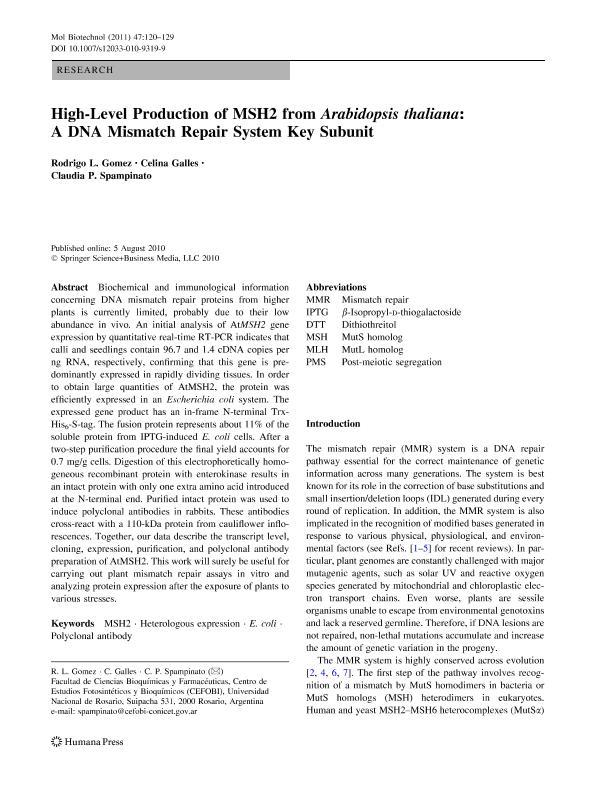Mostrar el registro sencillo del ítem
dc.contributor.author
Gomez, Rodrigo Lionel

dc.contributor.author
Galles, Celina

dc.contributor.author
Spampinato, Claudia Patricia

dc.date.available
2017-04-18T21:25:44Z
dc.date.issued
2011-02
dc.identifier.citation
Gomez, Rodrigo Lionel; Galles, Celina; Spampinato, Claudia Patricia; High-level production of MSH2 from Arabidopsis thaliana: a DNA mismatch repair system key subunit; Humana Press; Molecular Biotechnology; 47; 2; 2-2011; 120-129
dc.identifier.issn
1073-6085
dc.identifier.uri
http://hdl.handle.net/11336/15425
dc.description.abstract
Biochemical and immunological information concerning DNA mismatch repair proteins from higher plants is currently limited, probably due to their low abundance in vivo. An initial analysis of AtMSH2 gene expression by quantitative real-time RT-PCR indicates that calli and seedlings contain 96.7 and 1.4 cDNA copies per ng RNA, respectively, confirming that this gene is predominantly expressed in rapidly dividing tissues. In order to obtain large quantities of AtMSH2, the protein was efficiently expressed in an Escherichia coli system. The expressed gene product has an in-frame N-terminal Trx-His6-S-tag. The fusion protein represents about 11% of the soluble protein from IPTG-induced E. coli cells. After a two-step purification procedure the final yield accounts for 0.7 mg/g cells. Digestion of this electrophoretically homogeneous recombinant protein with enterokinase results in an intact protein with only one extra amino acid introduced at the N-terminal end. Purified intact protein was used to induce polyclonal antibodies in rabbits. These antibodies cross-react with a 110-kDa protein from cauliflower inflorescences. Together, our data describe the transcript level, cloning, expression, purification, and polyclonal antibody preparation of AtMSH2. This work will surely be useful for carrying out plant mismatch repair assays in vitro and analyzing protein expression after the exposure of plants to various stresses.
dc.format
application/pdf
dc.language.iso
eng
dc.publisher
Humana Press

dc.rights
info:eu-repo/semantics/openAccess
dc.rights.uri
https://creativecommons.org/licenses/by-nc-sa/2.5/ar/
dc.subject
Msh2
dc.subject
Heterologous Expression
dc.subject
E. Coli
dc.subject
Polyclonal Antibody
dc.subject
Msh2
dc.subject.classification
Bioquímica y Biología Molecular

dc.subject.classification
Ciencias Biológicas

dc.subject.classification
CIENCIAS NATURALES Y EXACTAS

dc.title
High-level production of MSH2 from Arabidopsis thaliana: a DNA mismatch repair system key subunit
dc.type
info:eu-repo/semantics/article
dc.type
info:ar-repo/semantics/artículo
dc.type
info:eu-repo/semantics/publishedVersion
dc.date.updated
2017-04-18T14:02:04Z
dc.identifier.eissn
1559-0305
dc.journal.volume
47
dc.journal.number
2
dc.journal.pagination
120-129
dc.journal.pais
Estados Unidos

dc.journal.ciudad
Nueva York
dc.description.fil
Fil: Gomez, Rodrigo Lionel. Consejo Nacional de Investigaciones Científicas y Técnicas. Centro Científico Tecnológico Rosario. Centro de Estudios Fotosintéticos y Bioquímicos (i); Argentina. Universidad Nacional de Rosario. Facultad de Ciencias Bioquímicas y Farmacéuticas; Argentina
dc.description.fil
Fil: Galles, Celina. Consejo Nacional de Investigaciones Científicas y Técnicas. Centro Científico Tecnológico Rosario. Centro de Estudios Fotosintéticos y Bioquímicos (i); Argentina. Universidad Nacional de Rosario. Facultad de Ciencias Bioquímicas y Farmacéuticas; Argentina
dc.description.fil
Fil: Spampinato, Claudia Patricia. Consejo Nacional de Investigaciones Científicas y Técnicas. Centro Científico Tecnológico Rosario. Centro de Estudios Fotosintéticos y Bioquímicos (i); Argentina. Universidad Nacional de Rosario. Facultad de Ciencias Bioquímicas y Farmacéuticas; Argentina
dc.journal.title
Molecular Biotechnology

dc.relation.alternativeid
info:eu-repo/semantics/altIdentifier/doi/http://dx.doi.org/10.1007/s12033-010-9319-9
dc.relation.alternativeid
info:eu-repo/semantics/altIdentifier/url/https://link.springer.com/article/10.1007%2Fs12033-010-9319-9
Archivos asociados
